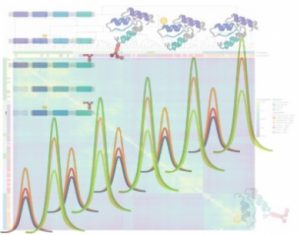Proteomics
Untargeted proteomics measures protein abundances within a sample. By profiling the differential expression of proteins in response to some alteration in condition (e.g. environmental stimuli, drug/toxin, dietary interventions), we can assess how the stimuli changes the proteome. Additional computational analysis of these changes in protein expression can then reveal pathways which are altered.
There are several different ways to quantify protein expression, each with its own advantages and disadvantages. We also have the capabilities to perform parallel label-free quantitative phosphoproteomics, performed in tandem with label-free proteomics. If you are unsure of what type of methods you need to use, we will help you decide which method is most appropriate for your research methods, experimental design, and questions.
For quantitation, we offer:
- Label-Free Quantitation: No labelling or sample pre-treatment is required for analysis. Proteins are quantified at the peptide level. Since the samples cannot be differentiated by labelling, each biological sample needs to be measured separately.
- TMT – Tandem Mass Tags: TMTs are chemical labels that typically react to amines on proteins. Up to 16 different TMTs can be used enabling up to 16 different experimental conditions to be labelled differently. Since the TMTs only vary in their isotopic configurations, the samples can be combined prior to analysis enabling all samples to be compared in a single mass spectrometry run.
- SILAC – Stable Isotope Labelling by Amino Acids in Cell Culture: Cells to be compared are grown in different media containing normal (termed light) and isotopically labelled (termed heavy) amino acids. Incorporation of these heavy amino acids into proteins causes a mass shift of the protein which can be detected by mass spectrometry. If both samples are combined, the ratio of light to heavy proteins detected reflects the protein abundance.
For quantitative proteomics, our MS data is collected using an Orbitrap Q-Exactive instrument. Our data is generally processed using FragPipe and MAxQuant. For a full list of data analysis options, please see our page for data analysis services.

In addition to untargeted proteomics, we also offer the following protein identification services:
- Identifying proteins/peptides from gels.
- Protein and peptide identification from solution.
- e.g. confirmation of a purified protein,
- identifying interacting proteins from an affinity-purification or pull-down experiment,
- De novo peptide sequencing using a variety of MS/MS fragmentation techniques.
For gel samples:
- Wash the gel thoroughly in sterile filtered 18 ohm water.
- Make sure to use gloves throughout to avoid keratin contamination.
- Use a clean container that has not previously been used for Western Blot analysis.
- Place the gel on a clean glass slide under a flow hood.
- Cut out the gel bands as close as possible around the band of interest and place in an Eppendorf tube that has been autoclaved.
- Alternatively, if you would rather have the facilities cut the bands, please provide the whole gel in sterile filtered 18 ohm water and an annotated picture detailing which bands are to be analyzed.
- Submit the sample along with a picture of the gel and information on the type of stain used so we can estimate the sample concentration ready for analysis.
For Affinity-purified mass spectrometry (AP-MS) or pull-down experiments (solution) experiments:
- We need at least 10 µg of protein to perform the digestion and analysis steps.
- All samples will be digested with Tyrpsin or Lys-C (or both). Other proteases are available upon request, but may add to sample cost and wait time.
- We can perform the digestion either on the eluted protein sample or whilst attached to beads.
- In all cases, please provide information as to the bait protein/antibody being used.
- Note: for all pull down experiments a minimum of two samples are required: your sample and a negative control. This allows us to distinguish protein interactors from any contaminant proteins present.
For in-solution, non-digested samples of isolated proteins:
- We require a minimum of 10 µg of protein.
- Please provide details of the buffer composition that the sample is provided in.
Note for any sample submission:
- PEG, glycerol and detergent are not amenable to mass spectrometry analysis and must be removed prior to sample submission.
- Analysis on lower sample volumes and concentrations can be attempted but results are not guaranteed.
- Alternative proteases can be used upon request.